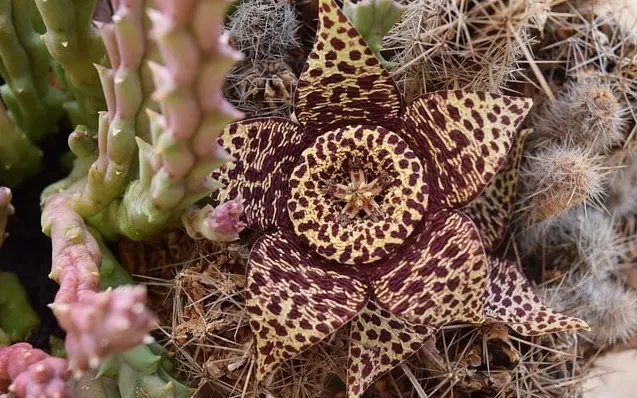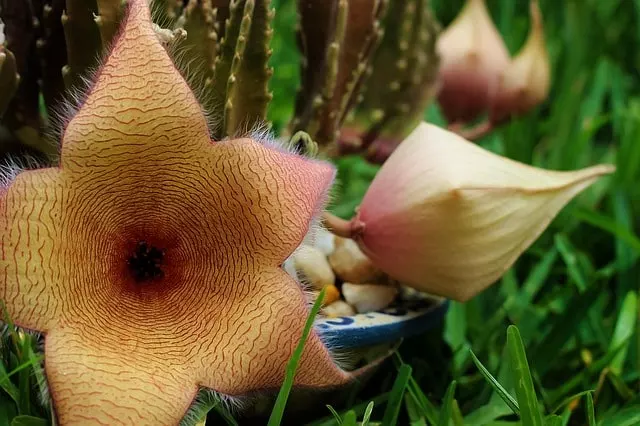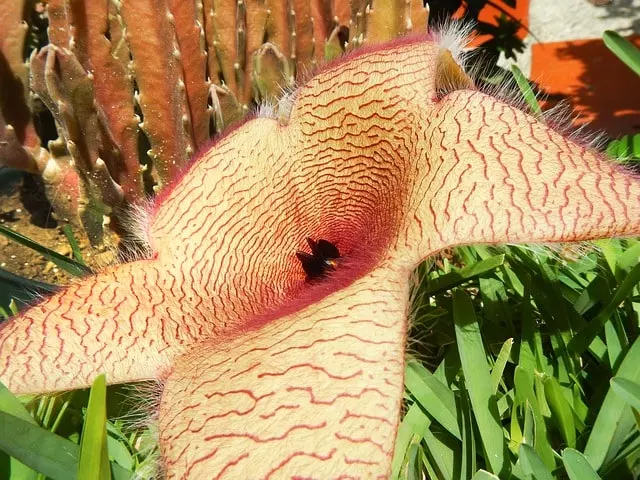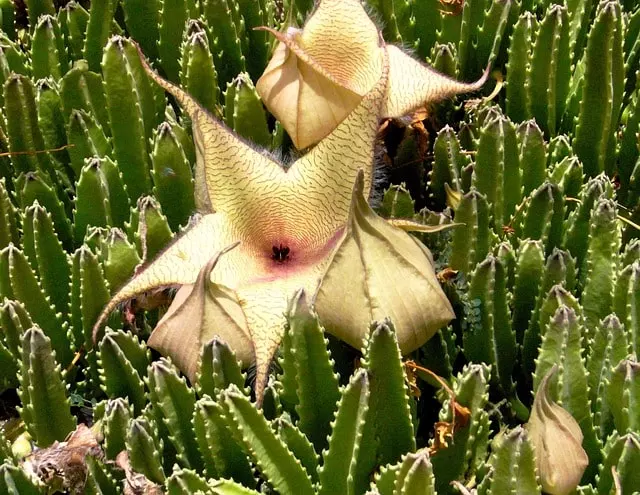The Stapelia plant is a hard one to forget. Whether it’s for its large, distinctive flower, which Stranger Things fans will recognize at first glance, or for the fetid scent it gives off, Stapelia leaves an impression that, while striking, is not for everyone. Learn all about Stapelia care in this article.
Perhaps it is precisely because of this eccentric touch that many choose to include it in their collections or gardens because it is a unique plant. If you want to learn more about what kind of plant Stapelia is, join us in this article.
Table of Contents
Characteristics of Stapelia
Let’s start by getting to know a little better the main characteristics of the Stapelia plant:
It is a whole genus of plants of the Apocynaceae family, with about 50 species, all of them succulent plants and originating in South Africa.
Among the different types of Stapelia, we find some of the best known, such as Stapelia Variegata, Stapelia Gigantea, Stapelia Flavopurpurea, and Stapelia Grandiflora, the most common one in gardening.
They are slow-growing plants, well known for their showy flowers, which can reach diameters of up to 16” (40 cm) in the larger species. The Stapelia flower stands out not only for its striking appearance but also, as we have mentioned, for the fetid aroma that we will recognize if we come close to smell it. This response to the need to attract their pollinators, which are none other than the blue flies. There is a variety, however, the Stapelia Flavopurpurea, whose smell is not unpleasant, reminiscent of beeswax.

When Do Stapelia Bloom?
The striking and fragrant flowers appear between summer and autumn, so in the cold months, it is possible to move the plant indoors without the danger of it perfuming the home with an unpleasant odor.

Stapelia Care – Location and Climate
Like many succulent plants, Stapelia is not particularly fussy about its care. They are adapted to warm to temperate temperatures and dry climates, with an optimum temperature of about 77°F (25 ºC) in spring and summer, although from 68°F (20 ºC) the plant is already doing well.
In the cold months, we should never expose it to temperatures below 50°F (10 ºC), since lower temperatures cause considerable damage and could even kill it. Bearing this in mind, of course, that it survives frost is ruled out.
Regarding the light, the plant needs at least a semi-shade exposure, although in environments without a very strong sun it will appreciate direct exposure. If you see that the stems of your Stapelia turn reddish or purplish tones, it means that the plant is stressed by receiving too much intense sun, and you will need to put it a little more undercover.
Stapelia Care – Watering
Despite being succulent, the Stapelia is not a cactus and needs more abundant watering than these. However, when it comes to knowing how to care for Stapelia, it is vital to keep in mind that, like most plants of its characteristics, it does not tolerate waterlogging at all.
Water it frequently but sparingly, making sure that the soil never dries out completely, but always be careful to avoid waterlogging the soil or the pot. If this happens, the roots of your Stapelia will likely be affected by rot. At this point, it is always better to under-pot than over-pot. If you notice that the stems of your plant are beginning to shrivel and lose volume
Stapelia Care – Soil
Here the plant is not demanding at all, being one of the main reasons why it is so easy to grow. The only important thing that you have to maintain is that the soil offers the best possible drainage, to avoid accumulations of water that would damage the plant.
Any sandy and light mixture will do, to which you can add vermiculite and perlite to improve its properties. We recommend this soil for the proper care of Stapelia (Order it here).

Vegetative Stage
This is one of those plants that appreciate spending a few winter months at a lower temperature to enter into a state of winter rest. When winter arrives, place it in an area around 59°F (15 ºC) and significantly reduce the frequency of watering so that the plant enters into rest, so that when spring arrives it will be reactivated with more energy.
Where to Buy Stapelia?
If you don’t have a Stapelia yet and you want to have this beautiful succulent, here is where you can get the best Stapelia specimens.
- We guarantee plant's safe arrival otherwise we will refund or send you a replacement plant
- Your package will be shipped carefully and meticulously bubblewrapped. When opening your package, some soil may be loose in the box. Plant orders are shipped within 3-5 days depending on availability of the plant. We'll try to ship during the week to avoid weekend delay. If you need your order urgently, please message us so we can upgrade your shipping.
- NOTES: We ship all year round, if your area is cold (under 40 degree), please consider purchasing a Heat Pack to add to your order: https://www.amazon.com/dp/B0BL74D964?ref=myi_title_dp
- We guarantee plant's safe arrival otherwise we will refund or send you a replacement plant
We hope you have learned how to care for Stapelia correctly.


